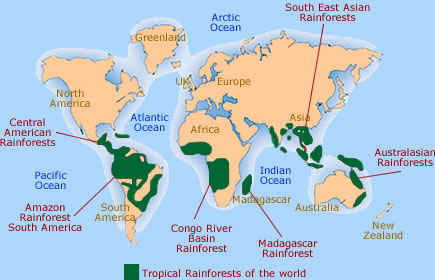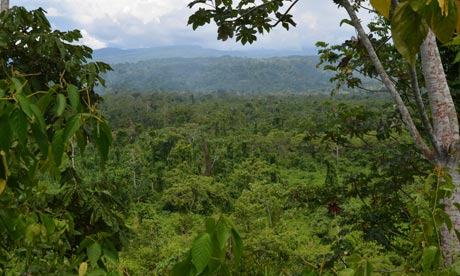 Lemurs are primates with a very restricted range, and are only found on the tropical island of Madagascar. They are arboreal, living in the treetops of the Madagascar rainforests along the north-south axis on the east coast of the island. The forests are tropical in climate: warm and humid. The east side of the island gets, on average, 3.5 meters of rainfall each year and is home to thousands of species of animals, insects, and plant life (including a vast array of trees for these lemurs to call "home").
Lemurs are primates with a very restricted range, and are only found on the tropical island of Madagascar. They are arboreal, living in the treetops of the Madagascar rainforests along the north-south axis on the east coast of the island. The forests are tropical in climate: warm and humid. The east side of the island gets, on average, 3.5 meters of rainfall each year and is home to thousands of species of animals, insects, and plant life (including a vast array of trees for these lemurs to call "home"). Because Lemurs are tree-dwellers their diet consists primarily of fruits and seeds found in the tops of trees. However, some families of Lemurs (like the Aye Aye) prey on frogs, insects, eggs and newly hatched birds (also found in tree tops).
Since Lemurs are arbhoreal, it makes sense that, over time, they have adapted to any and all food sources available to them. This adaptation is expressed in their omnivorous dietary trait.
 |
| Aye Aye (lemur) eating from a bird's egg. |
Spider Monkey (New World Monkey/Platyrrhini)
Like the lemur, they have adapted to a variety of foods, eating what is available to them in their surrounding environment and providing them with an abundance of food choices.
 |
| Spider monkey eating fruit. |
Baboon (Old World Monkey/Cercopithecidae)
 |
| African grassland, sub-saharan. |
The baboon is a hunter as well as a forager, sometimes feeding on other primates and the young of larger mammals such as antelopes. They are even known to hunt flamingos. While foraging, they will eat grass, seeds, roots, bark and fruit from trees. Baboons are also opportunistic in their diet and will eat the crops on farms, becoming a pest for African farmers.
 |
| Baboon feeding on an antelope in a tree top. |
Similarily to other primates, baboons have adapted their diets to meet the opportunities found in their environment. Being omnivorous and opportunistic provide them a greater chance of finding food all across the sub-saharan terrain.
Gibbon (Lesser Ape/Hylobatidae)
 |
| Jungle in South-East Asia |
 |
| Mother and baby gibbons eating. |
Again, they have adapted to the food sources available to them and have developed a very generalized diet.
Chimpanzee (Great Ape/Hominidae)
 |
| Central African rainforest. |
Chimpanzees live in the tropical rainforests of central Africa. Though it recieves less rainfall than most (only 68-73 inches annually), the rainforests of central Africa are still rich in bio-diversity in regards to plant, insect, and mammalian life. Similar to other forests, trees account for aproximately 70% of the plant life (600 different species), providing a great home for the arboreal and terrestrial chimpanzee. The forests in central Africa are home to the tallest species of rain forest tree, the Kapok. Also like other rainforests, the trees are incredibly densely packed and it can take up to 10 minutes for rain to hit the forest floor.
 |
| Chimpanzee feeding on fruit. |
| Mother and baby chimpanzee eating. |
While these five primates have adapted to finding food in their separate environments, they have not developed a particularly specialized diet. Each primate lives in an environment that is rich in bio-diversity, providing an abundant source of foods and allowing them to adapt to eating a wide variety in their omnivorous diets. Evolutionarily speaking, this provides these primates with an advantage when resources become scarce. Because their diets are so generalized, when a food source runs out they still have options.
 |
| Rainforests of the world. |
Sources:

Hello T,
ReplyDeleteYour post is full of easy to read information in a well structured manner. Very cool to see how these traits really come together as I read some of the other related post. This assignment shows how environment plays a key role. Primates adjust to meet the required needs around them. Some was can be seen as extreme and unique. Moreover, the environment adjust to the primates. And when the adjusts can't be made, the species goes extinct. For example, hunting for the purpose of exporting exotic meat out of the country is an example of how the adjustments can be set off balance, causing low numbers in many of the primates that we just studied. One of the figures in chapter seven reflected how low the numbers actually are. Clearing of the natural habitat of these primates is another good example of how an off balance can be created. I found it interesting how primates such as the chimpanzee will eat leaves and vegetation most of the time; however, the chimpanzee will also hunt and eat mammals, proving that this primate is adaptable in diet. My blog highlighted the locomotor pattern movements. The movement patterns traits adjust and adapt to the environment like the diet patterns, as do the other patterns. Your post are always well thought out.
Thank you for the positive feedback! I always appreciate it!
DeleteThis comment has been removed by the author.
ReplyDeleteVery thorough post!
ReplyDeleteLove the image of the aye-aye. Now there is a primate face that only a mother could love! :-) Must make sure you understand that the aye-aye is essentially an "outlier" in the lemur group and doesn't represent your average lemur. Otherwise, good.
Well done on the other primates as well. Very thorough. The only point I would like to challenge is the following statement you made about chimpanzees.
"...they have not been forced to adapt to any single food source, but have the ability and desire to feed on a wide-array of sources."
There are two ways to look at it. One is the way you have suggested, that evolution is essentially more "relaxed" because of the biodiversity, but remember that diet is not just an issue of eating what is available. Your digestive system needs to adapt as well to diet and that takes time. An organism that is primarily vegetarian will have a different digestive system from one that is primarily carnivorous because it needs to break down different items. This applies to omnivores as well. Omnivores (such as chimpanzees and humans) have a digestive system that can break down just about anything, and that digestive system is a product of natural selection. It took time for it to develop and it wouldn't have happened "just because". It would have happened because it provided an adaptive advantage to the organism to be able to eat whatever was available, probably because there were times when some options were unavailable and they had to switch to others. This is a more nuanced view of how evolution works. Less passive. More far reaching in its effects.
Other than this point (no deductions), great post and good work on all of those images. They helped explain your points well.
Thank you, Dr. Rodriguez! I appreciate (as always) your positive and INFORMATIVE feedback to my blog posts! You always give me either more information, or a different way to view it. Thanks!
DeleteAlso, dually noted re: the Aye Aye. And, also regarding the Aye Aye...I find the picture absolutely creepy.
After all of the research I have been doing on primates...I have to admit they are kind of scary. Not at all the cuddly little things one might expect.
Thank you for the response. Yes, the aye-aye is the saddest looking member of the primate family. There are so many cute ones out there (check out the golden lion tamarin and the mouse lemur). The aye-aye was definitely the last one in line when they were handing out the "cute" genes. :-)
DeleteI really enjoyed your post! It was written and structured very well and very informative. The pictures of each primates environment along side a picture of themselves gave me a good idea of what they are working with daily. I did not know that chimpanzees eat small animals too, like the baboons! I would think that would not be part of their food source with so much other things to eat. I agree with you also about their food sources being so generalized. With so many options available to them their ability to adapt when and if one is gone is really amazing. No picky eaters here!
ReplyDeleteMonisukka,
Delete"No picky eaters here." Ha! I hadn't even thought of it in those terms. Love that. Very valid.
Thanks for the feedback!